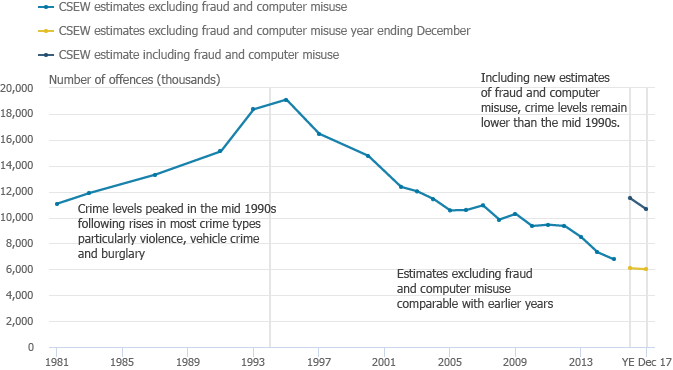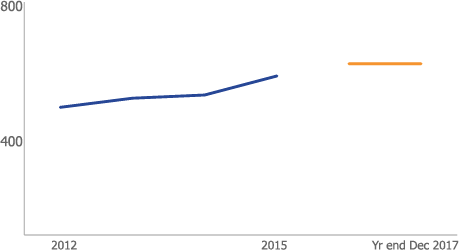Crime in England and Wales: year ending December 2017
Crime against households and adults, also including data on crime experienced by children, and crimes against businesses and society.
Released date: 26 April 2018
Next release: 19 July 2018 (provisional)
This is part of the latest release | View previous releases
Over the long-term, crime has fallen, but some crimes have risen slightly in the previous 12 months
England and Wales, year ending December 1981 to year ending December 2017

Source: Crime Survey for England and Wales, Office for National Statistics
- Crimes involving knives or other sharp instruments rose 26% from 32,468 to 39,598.
- Robbery has increased 33% from 55,892 to 74,130.
- 8 in 10 people were not a victim of crime in the previous 12 months.
Sections
Summary
Crime overall has fallen in the last year
Crime estimated by Crime Survey for England and Wales (CSEW) shows crime overall has fallen in the last year, driven by a 28% decline in computer misuse.
Most individual types of crime, including violence, have stayed at levels similar to the previous year.
When looking at the main types of crime, changes were only seen in:
- computer misuse offences (28% decrease to 1.37 million offences), which drove the fall in overall CSEW crime
- vehicle-related thefts (17% increase to 929,000 offences)
The increase in vehicle-related thefts is supported by a 16% increase in vehicle offences recorded by the police to 452,683 offences; a category that is well reported to the police and thought to be well recorded.
All other main types of crime measured by the survey showed no change.
Police recorded crime
Police recorded crime data showed evidence of rises in some other categories of crime, particularly the more harmful, less frequently-occurring offences.
The police figures indicate rises in the following types of crime:
- offences involving knives or sharp instrument (up 22% to 39,598 recorded offences)
- offences involving firearms (up 11% to 6,604 recorded offences)
These offences tend to be disproportionately concentrated in London and other metropolitan areas; however, the majority of police force areas saw rises in these types of violent crime.
Police recorded crime also showed rises in:
- burglary, which increased by 9% (up to 438,971 offences)
- robbery (up 33% to 74,130 offences)
- homicides
There were 54 more homicides than the previous year, a 9% rise to 653, excluding exceptional incidents with multiple victims such as the such as the terrorist attacks in London and Manchester, and events at Hillsborough in 1989, which were recorded as homicides in last year’s figures.
Including these exceptional incidents the total number of homicides recorded by the police fell by 1% (to 688).
Likelihood of being a victim has fallen considerably
Around 4 in 10 adults were estimated to have been a victim of crime in 1995; before the survey included fraud and computer misuse in its coverage. In the year ending December 2017, just over 1 in 10 adults were a victim of crimes comparable with those measured in the 1995 survey. Including fraud and computer misuse, 2 in 10 adults were a victim of crime in the year ending December 2017.
Data
This bulletin mainly reports on data from two sources of crime data: the Crime Survey for England and Wales (CSEW) and police recorded crime.
More information on both these sources can be found in the User guide to crime statistics for England and Wales.
Need to know
In this release
Fraud in England and Wales
No change in the volume of fraud offences in the last year

What you need to know
Police recorded crime data are not designated as National Statistics.
Violence crime in England and Wales
Little change in levels of violent crime in recent years

What you need to know
Police recorded crime data are not designated as National Statistics.
Weapons crime in England and Wales
Police recorded 7,130 (22%) more crimes involving weapons, with knife crime in cities rising most

What you need to know
Police recorded crime data are not designated as National Statistics.
Contact
Mark Bangs
crimestatistics@ons.gov.uk
+44 (0)2075 928689

